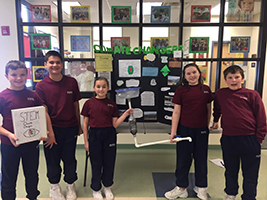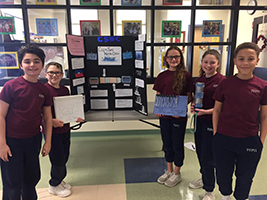
The following blog was contributed by Sarah Kerins, Ed.D., Principal at Pope John Paul II Regional Catholic Elementary School in West Brandywine, PA.
As Catholic administrators, our aim is to implement a vision for our school which is to be first and foremost driven by our Catholic mission as well as academically excellent. Many schools are embracing STEM, or in our case, STREAM, to put our schools on the cutting edge of innovation. When the administrative team at Pope John Paul II Regional Catholic Elementary School met to set a vision and goals for our STREAM program, we discussed two key questions. First, how do we make STREAM meaningful and not just another buzzword? Second, how do we accomplish our goals without breaking the bank?
 This school year, our team launched an initiative we branded STREAM-fusion. The name describes our goal which is to infuse STREAM concepts with the regular curriculum. After all, the STREAM movement was meant to have an integrative approach. STREAM should not be just engineering for the sake of engineering. Stand-alone maker-spaces, while they give students the opportunity to create and explore, can sometimes miss the broader picture if they lack direction or purpose.
This school year, our team launched an initiative we branded STREAM-fusion. The name describes our goal which is to infuse STREAM concepts with the regular curriculum. After all, the STREAM movement was meant to have an integrative approach. STREAM should not be just engineering for the sake of engineering. Stand-alone maker-spaces, while they give students the opportunity to create and explore, can sometimes miss the broader picture if they lack direction or purpose.
Like most Catholic schools, we had to make strategic but fiscally responsible decisions to implement our vision. We hired a STREAM coordinator and replaced the traditional computer technology course for students in grades K-4. Investing in the right personnel was perhaps more important than purchasing tools or materials. The scope of the STREAM course integrates content from across the curriculum. The STREAM coordinator also serves as a consultant and resource for our middle school faculty to help guide and support their efforts to design unit plans with STREAM components. A copy of our STREAM integration guide can be found here.
 Three years ago, I had the opportunity to attend NCEA’s STREAM conference held in Philadelphia where I first heard the founder of ProjectEngin, Ann Kaiser, describe the successes of the Archdiocese of Newark’s STREAM Expo. I was intrigued by the concept and revisited the presentation at the national conference in 2018. We were able to leverage our professional development funds to hire Ann as a consultant and trained the faculty to replace our traditional science fair with a new STREAM Expo. The students were required to design and engineer a prototype of a product which solves a real world problem. The Sustainable Development Goals developed by the United Nations provided direction for identifying a problem, and the ProjectEngin curriculum included resources for also identifying regions of the globe where the goals need to be addressed.
Three years ago, I had the opportunity to attend NCEA’s STREAM conference held in Philadelphia where I first heard the founder of ProjectEngin, Ann Kaiser, describe the successes of the Archdiocese of Newark’s STREAM Expo. I was intrigued by the concept and revisited the presentation at the national conference in 2018. We were able to leverage our professional development funds to hire Ann as a consultant and trained the faculty to replace our traditional science fair with a new STREAM Expo. The students were required to design and engineer a prototype of a product which solves a real world problem. The Sustainable Development Goals developed by the United Nations provided direction for identifying a problem, and the ProjectEngin curriculum included resources for also identifying regions of the globe where the goals need to be addressed.
Many times for STEM projects at the elementary level, teachers provide students with a method and parameters for an outcome. In this project, students had to invent a product and develop constraints and criteria. One of the most challenging aspects of creating their prototype was making decisions as a team. The process is thoroughly documented using an engineering design notebook which was an important step for students to truly understand the engineering design process. The results were astounding! I watched fifth grade students build a water drainage pipe with a valve and a filter which truly filtered dirty water to perfectly clear. Another group designed cloth infused with mosquito repellent, and our overall winner created biodegradable plastic. The students were required to explain how their design solution reflected Catholic values and beliefs; this became one of the most important aspects of the projects.
 While the ProjectEngin STREAM Expo was our focus this year, it is still only one component of our overall STREAM program. My advice to administrators looking to implement a vision for STREAM is threefold. First, invest in the right personnel who can help write or adapt curriculum. Second, the make-and-take workshop instructors are right; you can implement a STREAM program using everyday dollar store materials or supplies from a hardware store. The difference is in the unit plan. Every STREAM project needs purpose so it does not become disjointed—engineering for the sake of engineering—or simply a craft. Projects also need to live by constraints and criteria even if first developed by the teacher. Finally, implementation requires a strategic plan which is carefully crafted and supported with resources and professional development. Having the right support for your teachers is the key to success in all curricular initiatives!
While the ProjectEngin STREAM Expo was our focus this year, it is still only one component of our overall STREAM program. My advice to administrators looking to implement a vision for STREAM is threefold. First, invest in the right personnel who can help write or adapt curriculum. Second, the make-and-take workshop instructors are right; you can implement a STREAM program using everyday dollar store materials or supplies from a hardware store. The difference is in the unit plan. Every STREAM project needs purpose so it does not become disjointed—engineering for the sake of engineering—or simply a craft. Projects also need to live by constraints and criteria even if first developed by the teacher. Finally, implementation requires a strategic plan which is carefully crafted and supported with resources and professional development. Having the right support for your teachers is the key to success in all curricular initiatives!